Brake Systems
- Brake/Shift Levers
- Caliper Brakes (Road)
- Cantilever Brakes (MTB)
- Brake Levers
- Brake Shifter Combination Levers
- Brake Boosters
- Brake Cables
- Brake Carriers
- Brake Hangers
- Brake Pads
- Titanium Brake Hardware
Computers
Cranks and Chainrings
Forks
Frames & Framesets
Freewheels and Cassettes
Front Derailleurs
Grips
Handlebars
Handlebar Extensions
Headsets
Helmets
Hubs and Skewers
Lubricants
Metal Guide - Bicycle Metallurgy
Mirrors
Pedals and Toe Clips
Pumps and Inflation Systems
Racks
Rear Derailleurs
Rims & Rimstrips
Saddles
Seatposts and Binder Bolts
SRP Replacement Titanium &
Aluminum parts - Master Index
Stems
Tires
Tubes
Shoes
Spokes (Tables Only)
Tools - Bicycle Repair Tools
Yakima Fit List -to fit all cars
Notes
Links
Home
Shimano Brake / Shift Lever Combinations
MOUNTAIN BRAKE / SHIFT LEVER UNITS
Shimano is the major company making Brake / Shift levers for mountain use. Please read these reviews in the order presented, so we can avoid explaining the same principles with each of the three items. We chose top write about the XTR first because it is the longest in production of the 3 and wanted to discuss how the Rapid Fire shifter has changed in the current Optical Gear Display version. Incidentally this the last year the M900 will be made. For 1995 Shimano will introduce an OGD version of the XTR brake/shifter.
We want to remind you that all indexing systems for shifting reside only in the shifter. Any rear derailleur can be used with any indexed shifter, there are some very fine adjustments that are invisibly built into "systems" but the indexing will function with any index shifter. Some makers of bike parts have chains and rear gears that might add speed to achieving the shift. These Shimano shift systems are designed to use the industry standard of 4.8mm spacing on-center between rear sprockets. They will work with any rear changer, chain, or cassette...no matter who made it.
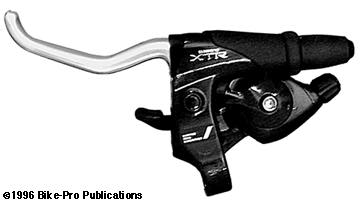
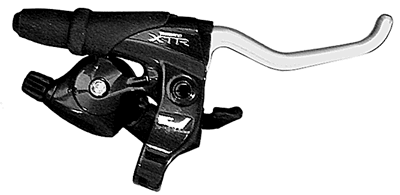
SHIMANO XTR M900 BRAKE/SHIFTER
The M900 was first released in the 1992 model year (late 1991) and is the first of the 8 speed off road components groups. We are going to discuss the brake lever aspect of the M900 first. The handle and clamp section are both made of forged aluminum. The handle's installation into the clamp section is a complicated affair. The complexity comes from wanting the lever to function smoothly, have "ServoWave" capability and keep the handle fastening system largely hidden.
There are many riders who have the belief that "ServoWave" makes active the brake cable housing, by pushing on the housing while the cable is being pulled through its interior. This is myth that has stood un-corrected.
The lead end of the brake cable fits into a Black plastic cable anchor. The cable anchor is pinned to the arm and slides back and forth smoothly as it is pulled backward by the handle. This plastic cable end anchor slides well ahead of the handle inside the clamp housing and allows fast braking because it isn't dependent on the pivot feature to draw the cable slack up first before pulling the cable. The pin that passes through the plastic anchor holding it to the handle has cylindrical nylon ends. These nylon ends function as "cam followers" inside the clamp housing to make the "Servo-Wave" feature. Inside the housing on each side is a set of ledges that these nylon rollers run against as the lever pulls the plastic cable end anchor.
The ledges have dips or "waves" built into them. As the nylon tipped pins roll over a peak inside the housing the brake cable is pulled more taunt, when they reach a dip or trough the cable becomes momentarily relaxed. This taunt and relax repetition, creates brake modulation, pulsing brake pad firmness through the pad contact. (You can't steer a wheel that isn't turning, it can only skid the wheel, this is the principle behind Anti-Lock Braking in automobiles.) One of the cam ledges to make the "wave" pattern is forged as a part of the aluminum housing. The other mated ledge or "cam" is molded of nylon plastic and held in place to the front of the lever with a tiny steel bolt and nut.
As the firmness of the riders grip continually changes the modulation/"servo-wave" condition gets continually repeated. The handle has a machined steel bushing that it pivots on. With the lever and cable anchor in place inside the housing, the steel bushing slides through the housing and handle. A tiny set screw with a 2mm hex fitting is tightened down onto a detent in the center of the bushing. The set screw holds the bushing and handle in place. This tiny set screw isn't likely to loosen up and is unable to fall off the lever set in use. Its position is covered by the lever return spring. Carbonworks makes a carbon fiber replacement for this aluminum handle. The original weighs 34 grams, the carbon replacement weighs 18.5 grams. Changing one for the other can be performed in 3 minutes by even an amateur, and the carbon replacement has the needed 2mm bushing set screw and the steel pin for the lever return spring to push on.
The M900 uses the two piece telescoping spring system found in the M733 XT brake lever. The spring is a the type used in a retractable ball point pen and is encased in a plastic capsule. One end has a hook shape and presses against a steel pin passing through the handle. The other end is round and fits into a round dimple in the clamp housing near the fastening bolt. The reach adjustment feature of this lever is more traditional than the rotating cam used in the M733 XT levers. In the M900 case a small steel set screw is used. Its 2mm hex fitting is accessed from the top of the lever near the shifter.
The lever fastening bolt which tightens the brake/shift lever to the handlebar is made of steel. It has 6mm by 1mm pitched threads, a 5mm hex fitting for tightening, a 15.5mm length and a 3.5 gram weight. The brake cable barrel (convenience) adjuster is made of aluminum with 10mm by 1mm pitched threads and a 4 gram weight. The piece is cut lengthwise to accommodate rapid cable installation. A Black plastic fixing nut is used to hold the barrel adjuster in place once set. The last brake lever piece is a rubber hood that fits over the cable adjuster pieces and tightly closes off completely access to the brake cable. The brake lever has 60mm of finger grip area.
The shifter assembly is mounted to the lever clamp assembly with a small steel bolt. The bolt has 5mm by .8mm threads, a 5mm hex fitting for tightening, a 11mm length and a 2.5 gram weight. This bolt can be replaced with Titanium water bottle cage bolt. The upper housing of the shifter is made of three pieces. There is an upper and lower Grey plastic shroud that enclose a stamped steel shifter position piece which also holds the shift cable barrel (convenience) adjuster. The position piece has four pins that emerge from its top surface. These fit into recessed holes in the bottom of the clamp assembly. There is just one way for the position to fit, and there are small arrows that line up to show the correct position.
The shifter mechanism also uses four pins to fix its position to the bottom of the position plate. When each of the parts are lined up and bolted, the lever clamp assembly holds all the pieces rigid relative to the handlebar. Pressing of the shift levers make the mechanism work around this mechanically fixed position. The inner workings of the shifter aren't important in this discussion and even Shimano replaces the shift mechanism entirely under warranty rather train people in small parts replacement which may not be effective. A lower plastic cover bolts into place protecting the inner shift parts. The shifter inner wire can easily be replaced. A hole through the shroud on the shifterÕs outer side is made to slide out the old and slip in a new shift wire. The shift cable convenience adjuster is made of steel, and under spring pressure to shorten the cable if revolved. Around the adjuster is a finger grip made of Grey plastic.
Theory of operation of the left or front chain ring shifter. There are two levers placed one over the other. The lower lever, when pressed shifts the chain to a larger chain ring. The lower lever, if pressed just halfway to the first "click" shifts the chain up just one chainring. If it's pressed the full travel distance it will shift the chain up two chain rings. The upper lever sits just ahead of and below the handlebar behind the brake lever and is meant to be actuated by the index finger. It has a total travel distance of 12mm Each time the upper lever is pulled toward the handlebar, the chain drops back just one chain ring. Two pulls of the upper lever bring you to the smallest (inner) from the biggest (outer).
Theory of operation of the right or rear sprocket shifter. Like the left lever there is two levers, one over the other. The lower lever accomplishes "up" shifts to lower gears on the rear hub. The lower lever has four "detents" or positions of momentary stop along its rotation. Pressing the lever to the first detent produces a "click" sound and a one gear rear upshift. If you chose, you can continue pressing the lever to the second detent where a second "click" will sound and another upshift will be performed. Continuing to press the lever will bring you to the third detent, with a third "click" and upshift. When pressed fully, you will hear the fourth click and four upshifts will have been performed. You do not have to slow down in the pressing of the shifter.
The four stage shift can be performed with a large lunge on the lever. The shifter, rear derailleur and chain will work out the details. If you try to push the lever beyond the lowest gear, meaning you have fully down shifted, the lever stops moving and won't allow you to shift further until you pull the upper trigger to up-shift. Though the XTR set has 8 speed rear gearing, to go from the highest (smallest) gear to the lowest (largest) will require two presses of the right up shift lever. The upper lever, like the left lever, is positioned ahead of the handlebar but behind the brake lever and has just 15mm of travel when pulled back toward the handlebar. Meant to be operated by the index finger, each pull slackens the shift cable so the rear dŽrailleur will shift once to a smaller (higher) gear. Shifting from the lowest (largest) gear to the highest (smallest) will require 7 separate index finger pulls.
The M900 set comes with a well constructed, heavy duty brake cable set with Grey housing weighing 166 grams. Shimano also includes a shift cable set and matching Grey housing weighing 89 grams. The rubber hoods on the brake lever weighs 12.5 per pair, while the brake lever part of the set weighs 213.5 grams. The right shift system with bolt weighs 97.5 grams, the left with bolt is 84.5 grams. The total set weight is 663 grams. This original model has been replaced by the 1995 model that has the optical gear display. The original sold for $149.99
1995 XTR BRAKE / SHIFT LEVER SET
The 1995 model year includes a replacement for the XTR brake/shifter set above. It is known that the new set will have an "Optical Gear Display", but not much more is known. They are expected to arrive for after market replacements in the US by either late 1994 or very early 1995. Though this will still be an 8 speed rear system. $ Price in Catalog
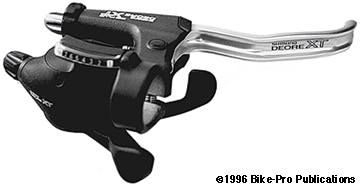
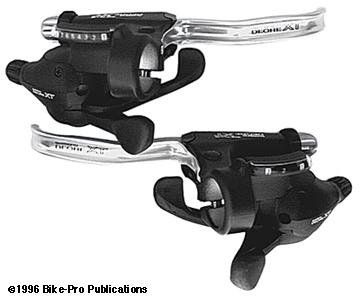
SHIMANO DEORE XT M737 BRAKE / SHIFT LEVER SET
First read the review of the M900 lever set, we are going to refer to it through out this review, largely because both levers solve the problems the same way. The brake lever and the clamp sections are forged of aluminum. The brake lever uses the "servo-wave" principle found in the M900 levers and it is employed the same way, using a cam following set of rollers at the end of the pin which holds the Black plastic cable anchor. One of the two cam sets is again a plastic piece that fits into the clamp section at the forward side of the lever and held by a machine screw. The cable anchor again fits deep into the housing so cable pull is actuated much faster than traditional pulling systems. The handle is held in the clamp like the M900. A machined steel bushing passes through the housing and handle, with a 2mm set screw turning into a detent in middle of the bushing.
The XT's lever return spring doesn't use the telescope type found in the M733 or M900. Instead it uses a coiled spring around the pivot in the style used by most brake levers, (SS-5, SS-7, Logic). One end of the spring sits in a hole in the handle while the other end pushes against the inside of the housing. The lever uses the same reach adjuster found on the M900 and the same cable barrel adjuster and fixing nut. The 6mm by 1mm fastening bolt has a 15.5mm length, a 5mm hex fitting, and a 3.5 gram weight. Though the handle appears to be Silver as though its left clear anodized, it is really painted in a Pearl Silver color. The Carbonworks XTR, XT handle can again replace the XT M737 handle. The original weighs 32 grams and the carbon version weighs 18.5 grams.
The shifter systems, front and rear operate the same as those used in the M900. These are slightly lighter through the more artful use of plastic., and a mechanical change is made in the internal ratcheting system. All external parts of the shift case are made of molded plastic, including the "OGD". Shimano has the position plate, (which was a separate piece enclosed by plastic case pieces in the M900), forged as a part of the clamp assembly. Making it this way, means the metal structure is all in the lever clamp piece, saves steps, expense and weight. The shifter systems are held to the lever by a custom bolt.
The new feature of the M737 XT shift system is the "Optical Gear Display". On the left shifter there is a visual indicator of the chain ring being used. A "1" in the display indicates use of the inner chain ring, while "2" is the mid and "3" is the outer. On the right shifter, the visual indicator shows which rear cog is being used. The display shows "8" when the chain is on the smallest cog and "1" when it is on the largest (lowest gear) cog. The Shimano information states that the shifter will only advance up to three positions on a full push of the lower right lever. We found that it actually shifts across four cogs not three, and appears to have been a typographical error. The OGD works because of a post that descends from the display unit and fits into a white nylon wheel that rotates with the internal shift winder. As the shifter winds one direction it rotates the post which rotates the Red indicator. Shifting the other way moves the post and indicator back again. The Optical Gear Display on either lever is made almost entirely of plastic and designed to be easily replaced. The same shift cable barrel (convenience) adjusters on the M737 are the same used on the M900.
The M737 set comes with a well constructed, heavy duty brake cable set with Black housing weighing 166 grams. Shimano also includes a shift cable set and matching Black housing weighing 89.5 grams. These seem to be the same cable sets used in the XTR version with Black rather than Grey housing. The left lever, complete, with brake and shift functions weighs 198 grams of which 99 grams is the shifter mechanism, its bolt and the display. The right lever complete, with brake and shift functions weighs 188 grams of which 93.5 grams is the shifter mechanism. The total set weight is 641.5 grams. $ Price in Catalog
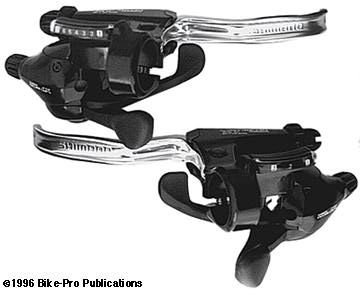
SHIMANO DEORE LX M564 BRAKE / SHIFT LEVER SET
There are very few differences between the M737 and M564 levers. There are different marks on the lower side of the clamp section to indicate that it is an "M564" rather than "M737". The plastic pieces are glossy Black instead of Grey. The painted surface of the aluminum parts are glossy Black rather than Grey. The actual handle of each lever is left in a Silver anodized finish, not painted like the M737, and has Shimano in raised lettering on the inner back side. The M737 has no raised lettering. The Carbonworks XTR, XT, LX lever can again be used to replace this aluminum version. The right lever of the LX M564 will only shift through 7 gears rather than the 8 gears of the XT which we can explain with the shift winder detail photos.
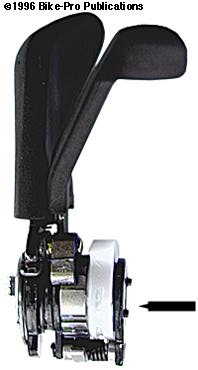
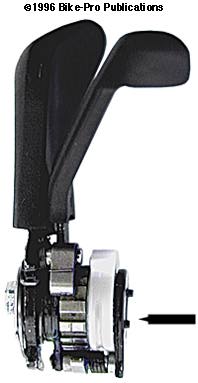
We took the right shift lever sets of the M737 and the M564 apart to see the exact difference. Each of these images is of the exposed right shift lever. The one on the left is the 7 speed model, the one on the right is the 8 speed. They are identical except the 8 speed lever has one added groove which makes the "8th detent" when shifting. It's hard to see, so we have a reference line at the sides of the shifter in the proper area to look at. Notice the clear square area on the left, it lacks the detent making it the 7 speed LX model. The XT one on the right has the extra groove making it an 8 speed shifter. (How much do you think it costs to put the piece in making it an 8 speed? How much do you think it costs to run two assembly lines making two near identical sets instead of one? $30 a unit?) Those are the differences. The left lever is so identical that it weighs 198 grams just like the XT M737 left lever. The right lever of each set also weighs exactly the same. The Optical Indicator has no weight bearing on this small lever change, and has a very minor adjustment made in the interior printing so the LX will show 7 rather than 8 speeds in the window. The right shifter like the M737, will shift through 4 gears with a single push.
The M564 set comes with a well constructed, heavy duty brake cable set with Black housing weighing 166 grams. Shimano also includes a shift cable set and matching Black housing weighing 89.5 grams. It is the same cable set used in the M737 XT lever set. The left lever, complete, with brake and shift functions weighs 198 grams. The right lever complete, with brake and shift functions weighs 188 grams. The total set weight is 641.5 grams. $ Price in Catalog
SHIMANO DEORE LX 8 SPEED
In the 1995 model year Shimano will introduce an 8 speed version of the LX Rapidfire brake/shift lever set. As we've pointed out in the above images the differences between them from a manufacturing point of view are insignificant in materials and time, (in fact we've hinted that it may take more time to keep a separate assembly line running). Frankly, the 8 speed version should cost no more than the 7 speed model because it will probably be the XT shifter used inside the new LX mechanism, but we expect the 8 speed to cost more.
Remember, you can upgrade the 7 speed version merely by ordering an 8 speed M737 right shifter replacement which will replace just the lower shifter component of the lever not the brake functions or the OGD. Shimano will be selling both the 7 and 8 speed models of the LX levers in the 1995 year and probably phase out the 7 speed version 1996. $ Price in Catalog

